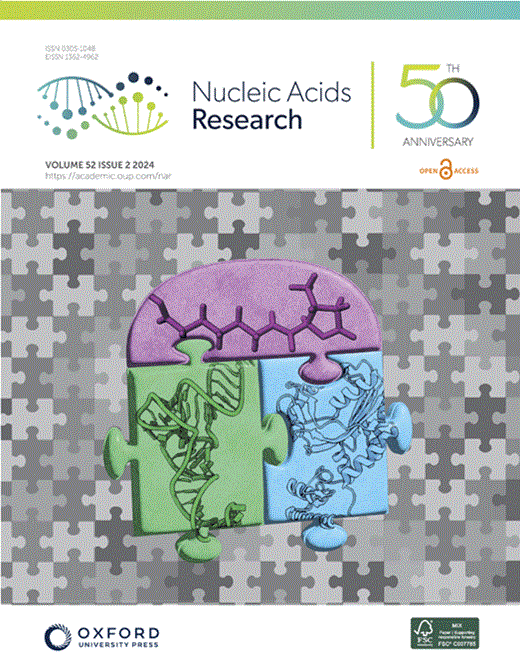Identification of transcription factor co-binding patterns with non-negative matrix factorization
IF 16.6
2区 生物学
Q1 BIOCHEMISTRY & MOLECULAR BIOLOGY
引用次数: 0
Abstract
Transcription factor (TF) binding to DNA is critical to transcription regulation. Although the binding properties of numerous individual TFs are well-documented, a more detailed comprehension of how TFs interact cooperatively with DNA is required. We present COBIND, a novel method based on non-negative matrix factorization (NMF) to identify TF co-binding patterns automatically. COBIND applies NMF to one-hot encoded regions flanking known TF binding sites (TFBSs) to pinpoint enriched DNA patterns at fixed distances. We applied COBIND to 5699 TFBS datasets from UniBind for 401 TFs in seven species. The method uncovered already established co-binding patterns and new co-binding configurations not yet reported in the literature and inferred through motif similarity and protein-protein interaction knowledge. Our extensive analyses across species revealed that 67% of the TFs shared a co-binding motif with other TFs from the same structural family. The co-binding patterns captured by COBIND are likely functionally relevant as they harbor higher evolutionarily conservation than isolated TFBSs. Open chromatin data from matching human cell lines further supported the co-binding predictions. Finally, we used single-molecule footprinting data from mouse embryonic stem cells to confirm that the COBIND-predicted co-binding events associated with some TFs likely occurred on the same DNA molecules.利用非负矩阵因式分解法识别转录因子共结合模式
转录因子(TF)与 DNA 的结合对转录调控至关重要。虽然许多单个 TF 的结合特性都有详细记载,但还需要更详细地了解 TF 如何与 DNA 相互合作。我们介绍了 COBIND,这是一种基于非负矩阵因式分解(NMF)的自动识别 TF 协同结合模式的新方法。COBIND 将 NMF 应用于已知 TF 结合位点(TFBSs)侧翼的单击编码区域,以精确定位固定距离的富集 DNA 模式。我们将 COBIND 应用于 UniBind 中 7 个物种中 401 个 TF 的 5699 个 TFBS 数据集。该方法发现了已经确定的共结合模式,以及文献中尚未报道的、通过主题相似性和蛋白质相互作用知识推断出的新的共结合构型。我们对不同物种的广泛分析表明,67%的TFs与同一结构家族的其他TFs共享共结合基序。COBIND捕获的共结合模式可能与功能相关,因为它们比孤立的TFBS具有更高的进化保守性。来自匹配人类细胞系的开放染色质数据进一步支持了共结合预测。最后,我们利用小鼠胚胎干细胞的单分子足迹数据证实了 COBIND 预测的与某些 TFs 相关的共结合事件可能发生在相同的 DNA 分子上。
本文章由计算机程序翻译,如有差异,请以英文原文为准。
求助全文
约1分钟内获得全文
求助全文
来源期刊

Nucleic Acids Research
生物-生化与分子生物学
CiteScore
27.10
自引率
4.70%
发文量
1057
审稿时长
2 months
期刊介绍:
Nucleic Acids Research (NAR) is a scientific journal that publishes research on various aspects of nucleic acids and proteins involved in nucleic acid metabolism and interactions. It covers areas such as chemistry and synthetic biology, computational biology, gene regulation, chromatin and epigenetics, genome integrity, repair and replication, genomics, molecular biology, nucleic acid enzymes, RNA, and structural biology. The journal also includes a Survey and Summary section for brief reviews. Additionally, each year, the first issue is dedicated to biological databases, and an issue in July focuses on web-based software resources for the biological community. Nucleic Acids Research is indexed by several services including Abstracts on Hygiene and Communicable Diseases, Animal Breeding Abstracts, Agricultural Engineering Abstracts, Agbiotech News and Information, BIOSIS Previews, CAB Abstracts, and EMBASE.
 求助内容:
求助内容: 应助结果提醒方式:
应助结果提醒方式:


